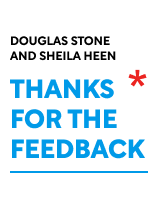

This article is an excerpt from the Shortform book guide to "Thanks for the Feedback" by Douglas Stone and Sheila Heen. Shortform has the world's best summaries and analyses of books you should be reading.
Like this article? Sign up for a free trial here .
What is Thanks for the Feedback about? How can becoming a better receiver of feedback help you in your life?
In their book Thanks for the Feedback, Douglas Stone and Sheila Heen, two of the co-authors of the bestseller Difficult Conversations, walk you through how to become a better receiver of feedback. You’ll learn what feedback is and how it works, how we typically react, triggers that cause us to react badly, and specific techniques you can use to successfully discuss feedback and then incorporate it into your life.
Here is a brief overview of Thanks for the Feedback by Douglas Stone and Sheila Heen.
Thanks for the Feedback: The Science and Art of Receiving Feedback Well
It can be hard to hear feedback, and consequently, there’s often a disconnect between a feedback-giver and a feedback-receiver: When a person receives feedback, she feels it’s unfair or untrue. But when she gives feedback, she feels the other person isn’t properly listening or understanding it. To reconcile this disconnect, organizations and self-help books often focus on teaching how to give feedback better. The key, though, is learning how to receive it better. After all, it is the receiver who controls whether or not feedback is understood, accepted, and adopted.
In their book Thanks for the Feedback, Douglas Stone and Sheila Heen walk you through how to become a better receiver of feedback so that you can more effectively incorporate it into your life and in doing so, improve your job performance and strengthen your personal relationships.
Here’s a quick summary of the key points.
What Is Feedback?
Feedback tells you how other people see you. People who consistently take feedback better are more successful in their lives and work. Being open to feedback allows for learning and growth. Being resistant to it allows problems to fester and escalate, and can ultimately destroy relationships.
There are three types of feedback:
- Evaluation is assessment. It tells you where you stand in relation to expectations and to other people. It aligns expectations between two people and clarifies consequences.
- Coaching is advice. It is feedback aimed at helping you improve, learn, grow, or change, either to meet new challenges or to correct an existing problem.
- Appreciation is recognition, motivation, and thanks. It lets you know that your efforts are noticed, making you feel worthwhile.
It’s important when seeking feedback that you are clear about what you’re looking for: evaluation, coaching, or appreciation. This will prevent confusion or frustration if you receive a different type of feedback than you’re expecting.
Understanding Triggers and Our Reactions
The primary difficulty when we receive feedback is that it triggers emotional responses that cloud our judgment and prevent us from properly comprehending the feedback. Understanding what sets you off and how your own particular wiring affects your reactions can help you get control over those reactions.
Our Instinctive Reactions
Your instinctive reaction to feedback involves three variables:
- Your baseline: your default emotional state. Some people are more naturally optimistic, others have more general anxiety.
- Your swing: the amount you move off your baseline when you receive feedback. Some people react more strongly than others to either positive or negative feedback.
- Your recovery: the duration of your reaction. Some people bounce back from setbacks faster than others. Some people maintain a positive boost for longer.
These three elements are heavily influenced by our emotions, which are often set off by certain triggers activated by feedback. Gaining control of your emotions involves fully understanding the triggers that produce them.
Three Triggers
“Triggers” are instinctive and usually negative knee-jerk responses that cause us to dismiss feedback or get angry about it. Triggers fall into three general categories:
- Truth triggers are our emotional responses to feedback we feel is wrong, unhelpful, or unfair.
- Relationship triggers are our emotional responses to the person giving the feedback more than the content of the feedback itself.
- Identity triggers happen when feedback threatens our sense of who we are.
Let’s explore each trigger in more detail.
Understanding Truth Triggers
When our truth trigger is activated, we object to the content of feedback, labeling it wrong, unhelpful, or unfair. To counter this instinct, fully examine the feedback so that you can properly decipher the “truth” of it.
Feedback Has Two Elements
Feedback generally has two elements: an element that looks back (“Here’s what I noticed”) and an element that looks forward (“Here’s what you should do”). The “looking back” piece is made up of observations and interpretations of those observations—how a person feels about them. The “looking forward” piece of feedback is about next steps: advice, consequences, and expectations.
To find common ground, recognize that different people have different “truths”: Your views on another person are subjective, your interpretations are not necessarily more correct than other peoples’, and your judgment of how to correct problems might differ.
Controlling Truth Triggers
Understanding feedback involves examining not only the other person’s thoughts and feelings, but also your own. There are two key strategies: finding your blind spots and looking for differences instead of “wrongs.”
Strategy 1: Find Your Blind Spots and Tells
A “blind spot” is something we ignore or attribute little importance to but that other people see clearly. When people give us feedback about a trait we’re blind to, we dismiss it as untrue. Recognizing our blind spots can prevent this. There are different categories of blind spots:
- Emotional distortion: Our emotional reaction to a situation usually seems much more intense to the person on the receiving end than it seems to the person giving the feedback.
- Behavioral patterns: A person often engages patterns of behavior that she herself is unaware of but others around her see clearly.
- Character versus circumstance: When we run into difficulty, we tend to attribute it to the circumstances around us, but other people might blame it on our character.
- Impact versus intent: We judge ourselves by our intentions, but others judge us by how our actions impact them.
- Your “tells”: Your face, voice, and other non-verbal behaviors can betray your true thoughts and emotions.
To become aware of your blind spots:
- Watch for your defensive reactions.
- Look for patterns of feedback that you receive from several sources.
- Record yourself so that you can see any tells you aren’t aware of.
- Get a second opinion if feedback still isn’t sitting right.
Strategy 2: Look for Differences and Rights, Not Wrongs
Instead of asking yourself why the feedback is wrong (“That’s not relevant”; “It’s right for you but not for me”; “You’re not understanding the full context”), acknowledge that you and the other person see things differently and try to figure out why. By mastering “difference-spotting” in this way, you will be able to better understand the other person’s views and move from “No, that’s wrong” to “Tell me more.”
Finally, ask yourself what’s right about the other person’s feedback. Figure out what about the feedback makes sense, what might be worth trying, and how you can find some meaning that might be helpful.
Understanding Relationship Triggers
Sometimes we react to feedback not because of the content of the feedback itself, but because of who gave it to us: It becomes about the who rather than the what. We can manage these relationship triggers by disentangling our reaction to the feedback from our reaction to the person giving it. There are two primary relationship triggers.
Relationship Trigger #1: Our Opinion of Them
When receiving feedback, we’re often quick to look for something that disqualifies the person from giving it. These are commonly:
- The giver’s skill or judgment: Did she give feedback in an appropriate way, at an appropriate time? (“How dare she bring this up in front of the client?”)
- Her credibility: Does she have relevant experience? (“She doesn’t have kids, what does she know?”)
- Her trustworthiness: (“She’s only saying that so that she can get the promotion.”)
Relationship Trigger #2: Their Treatment of Us
Our perception of how the other person treats us often determines whether or not we accept or ignore their feedback.
There are three general relationship elements that commonly affect us:
- Appreciation: If we feel we’ve gone to great efforts in some way, and those efforts are not acknowledged, we often react emotionally to that snub rather than listen to the other person’s feedback.
- Autonomy: When we feel someone is telling us what to do but does not have the authority to do so, we may reject her advice on the grounds of, “Who does she think she is?”
- Acceptance: We find it hard to take feedback from a person who doesn’t accept us as we are now, which is, ironically, what feedback is all about—change.
Switchtracking: A Common Response to Relationship Triggers
Often when we are relationship-triggered, we “switchtrack”: We respond to a piece of feedback with a reciprocal piece of feedback that is usually aimed at the person raising the issue rather than the issue itself. The conversation splits and starts following two entirely different tracks. For example, if your roommate tells you she’s tired of you not cleaning up the kitchen, and you respond, “Why are you always so critical of me?”, you’ve just switchtracked the conversation. When we don’t realize we are dealing with two separate topics, we end up talking over one another instead of resolving problems.
Controlling Relationship Triggers
Control your relationship triggers by properly managing switchtracking and then stepping back to see the whole system.
Manage Switchtracking
The goal in controlling a relationship trigger is to recognize when you have two topics on the table, and address each properly. Follow these guidelines:
- Spot the two topics: Be alert for conversations where one person raises an issue and the second person responds with a statement or question that focuses on the first person herself, instead of the content of the issue.
- Discuss the two topics: Give each topic its own track by acknowledging that you are now talking about two different things. Then, decide with the other person which topic to discuss first.
- Watch for additional triggers: Just because you’ve identified two separate topics doesn’t mean you are out of the woods. Be alert for ambiguities that might hint at deeper issues lurking below, and address them explicitly.
See the Whole System
Sometimes, we’re too close to a situation to see it clearly. Viewing your conflict as part of a system can help you get a fuller understanding of how and why you might be clashing with someone else.
A “system” is a set of parts that operates as a complex whole. Each part influences the others. Taking some steps back can help you see how you fit into the whole.
- Take one step back to discover intersections: Conflicts happen at “intersections” where differences in opinion, values, and habits cause friction, more than by one person being wrong.
- Take two steps back to examine roles and adversity: Roles have an effect on behavior and can create adversity between two people who otherwise would not conflict.
- Take three steps back to look at the big picture: The big picture includes other players, policies, and processes that influence peoples’ behavior and decisions, how they view each other, and the feedback they give each other.
Using a systems-focused lens will allow you to take control of the influences around you instead of being controlled by them.
Understanding Identity Triggers
Your identity is the story you tell yourself about yourself: what you’re good at, what you stand for, what you’re like. When feedback challenges this story, your sense of identity can start to collapse, and you’ve run into an identity trigger.
Controlling Identity Triggers
Get a handle on your identity triggers by adopting a growth mindset and approaching your emotional reactions thoughtfully.
Adopt a Growth Mindset
A person with a growth mindset sees her traits as evolving. She views feedback as commentary on her actions rather than her identity (“Last week I nailed my sales pitch; this week I dropped the ball”). She sees setbacks as opportunities for learning. A person with a fixed mindset sees her abilities as stable and finished. She views feedback as a commentary on her person (“Last week I was great, this week I’m a failure”). She sees setbacks as permanent failures.
To adopt a growth mindset:
- Listen for coaching rather than evaluation: Coaching doesn’t hint at who you are; it relates to what you do, so it’s easier to take.
- Separate judgment from evaluation: Focus on the assessment and consequences piece of an evaluation you receive; don’t fixate on how you think this reflects on you in the other person’s eyes.
- Give yourself a “shadow score”: Rate yourself on how well you handle the evaluation from the other person. Recognizing when you handle bad feedback well will help you bounce back from it sooner.
(Shortform note: To learn more about how to develop a growth mindset, read our summary of Grit.)
Approach Emotional Reactions Thoughtfully
Follow five steps to counter your emotional reactions thoughtfully.
- Be mindful: Be aware of your reactions in the moment—slow down when you feel yourself getting emotional.
- Separate your emotions from the story: Name your feelings explicitly so that you can judge how they are affecting your interpretation of the feedback.
- Contain the story: Don’t exaggerate possible consequences.
- Change your point of view: Imagine you’re an observer of your own situation, or imagine how you’ll see it five years from now. Try to see the humor in it that you’ll probably see one day in the future.
- Accept the limits of your control: Accept the fact that you can’t control how others feel about you. If you still can’t get a handle on your emotional reactions to feedback despite your best efforts, seek help from friends, family, or professionals.
Anatomy of a Feedback Conversation
Now that you understand your triggers and how to control them, we’ll explore how to get the most out of a feedback conversation. Broadly speaking, feedback conversations have three parts making up an overall arc:
- The open: where you get aligned with the other person
- The body: where you discuss the content of the feedback
- The close: where you clarify commitments, expectations, and follow-up
The Open
Get on the same page as your feedback-giver by asking yourself some questions:
- What kind of feedback is this? Evaluation, coaching, or appreciation?
- What is the giver’s intent?
- Who has the final word? When your manager gives you a suggestion, is it just that—a suggestion? Or is it a requirement?
- Is this feedback negotiable? Know up front if an evaluation is final or if there’s something you can do to change it.
The Body
This is the content part of the talk. Make sure to hit each of these points in this section:
- Listen: Really pay attention to your feedback-giver and ask focused questions to let her know you’re listening. Also listen to your own internal voice and watch for triggers.
- Clarify: Ask the other person to clarify her advice or to specify the consequences and her expectations.
- Add your own input: Complete the picture she’s painting by explaining your observations, interpretations, and feelings.
- Referee your conversation: Try to diagnose and describe communication problems as they come up so that you can propose solutions in real time.
The Close
When wrapping up your discussion, address:
- Action plan: Who is going to do what specifically when you each leave the meeting?
- Benchmarks: How will progress be measured?
- Consequences: What happens if the benchmarks are not met?
- Procedure: How are you going to approach this topic again?
- Strategies: If you’re not coming up with solutions that directly solve your conflict, what strategies will you each adopt to accommodate the other successfully?
Incorporating Feedback
At this point you’ve gotten a handle on how to understand feedback, how to respond to it, and how to have a feedback conversation. We’ll now look at the next step: what you do with that feedback, and how you can incorporate it into your life individually and in your organization.
Incorporating Feedback at an Individual Level
There are five techniques that can help you find specific ways to incorporate feedback into your life:
- Focus on one thing: Sometimes feedback has several strands and encompasses a wide area. Focus on just one specific aspect of it first.
- Look for options: Make sure you understand the other person’s true concerns and determine what your options are for addressing them.
- Test with small experiments: Try out advice on a small scale before committing to a larger change.
- Get properly motivated: Increase the benefits of positive changes by adding rewards. Increase the costs of not changing by adding more consequences. Keep in mind that when making changes, things will get harder before they get easier.
- Make the other person feel valued: Be open to her advice and she will likely later be open to your advice.
Incorporating Feedback at an Organizational Level
We’ll now discuss how your organization can improve its feedback system by examining three perspectives: senior leadership and HR, team leaders and coaches, and receivers.
Senior Leadership and HR
As the most visible players, a company’s leadership and HR are expected to spearhead performance management systems. There are some things you can do to help ensure success in that process.
- Promote a culture of learning: Talk to your employees about the benefits of a growth mentality and how it improves performance. Discuss feedback-receiving methods.
- Explain tradeoffs as well as benefits: Promote the benefits of any new evaluation system but also address possible shortcomings. This will help employees know what to expect.
- Set an example: Actively seek out input from those below you.
Team Leaders and Coaches
Improve your team’s feedback skills by modeling your own system, emphasizing the tradeoff between short-term pain and long-term gain, and being aware of individual differences among your teammates that affect how each reacts to feedback.
Receivers
The most important thing to remember is that as a receiver of feedback, you drive the process and control your own learning. Be proactive—seek out advice from those who can help you. Observe successful people and try to figure out what they’re doing differently. Be open, try out advice, and communicate clearly.
In the end, although learning is a shared experience, your own individual progress is up to you.

———End of Preview———
Like what you just read? Read the rest of the world's best book summary and analysis of Douglas Stone and Sheila Heen's "Thanks for the Feedback" at Shortform .
Here's what you'll find in our full Thanks for the Feedback summary :
- How to better receive feedback, rather than just giving it
- Why people tend to respond negatively towards feedback
- How to successfully incorporate feedback into your life






